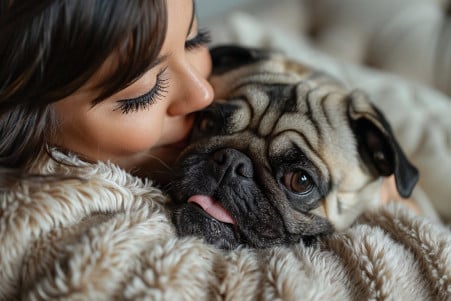Why Does My Dog Lick My Hands? Decoding Canine Behavior
17 February 2024 • Updated 16 February 2024

When your dog gives you those slobbery hand licks, it may mean more than you think. Dogs lick hands to show affection, get attention, or as a self-soothing behavior. They also learn to lick from their mothers when they are puppies, and they continue to use licking as a way to communicate and bond with their human family members. Licking can also be a sign of submission or a way to taste and explore.
If your dog licks too much, it may be a sign of anxiety or an underlying medical condition that needs to be addressed.
We’ll take a deep dive into the fascinating world of behavioral science, veterinary medicine, and psychology to uncover the reasons behind your dog’s licking behavior. This article includes information from scientific journals, expert interviews, and in-depth research on dog behavior. As we go through these materials, you’ll learn about the many layers of communication and emotion that play a role in this common yet often misunderstood part of the human-dog bond.
Why does my dog lick my hands?
Why Do Dogs Lick? The Psychology Behind Canine Behavior
When your dog licks your hands, it’s not just a sign of affection. According to Psychology Today, licking is a behavior that has a long evolutionary history and is rooted in the mother-infant relationship.
Puppies first learn to lick from their mothers, who use licking as a way to groom and care for their young. This early form of communication helps to establish a strong bond between mother and puppy and is a behavior that dogs carry with them into adulthood.
When dogs lick their owners, it’s a way of showing affection and seeking comfort. In fact, licking is often referred to as a dog’s version of a kiss and is a way for dogs to strengthen their emotional bonds with their owners. The Spruce Pets even suggests that licking is a way for dogs to show love and empathy, much like humans do.
At the same time, licking is also a way for dogs to show submission in their pack. According to A-Z Animals, licking is a way for dogs to greet one another, communicate their emotions, and show submission to a pack leader, which is often the dog’s owner. This means that licking is a complex form of communication that dogs use to send a variety of messages to their owners.
That said, it’s important to be aware of the potential downsides of licking. For example, if your dog licks you excessively, it could be a sign of an underlying behavioral issue, such as separation anxiety, or a sign that your dog is seeking attention.
In these cases, you may need to work with a professional dog trainer or behaviorist to address the issue. This is a good example of how licking can go from being a healthy way for dogs to show affection to a behavior that indicates an underlying issue.
Training Techniques: How to Stop Your Dog from Licking
Positive reinforcement, which is a key component of modern dog training, can be especially helpful when it comes to controlling your dog’s licking. As the American Kennel Club explains, positive reinforcement, which involves rewarding good behavior, helps your dog learn what’s expected of them without the use of punishment. So, reward your dog with a treat or a pat when you see them not licking.
Another way to help control your dog’s licking is to redirect their licking behavior to something more appropriate, like chewing on a toy or playing. This method works best when it’s done consistently and with good timing. Make sure to reward your dog right after they do the desired behavior so that they can make the connection.
As PetMD points out, it’s also important to make sure you’re using a reward that your dog actually likes since not all dogs are motivated by the same things.
It’s also important to know why your dog is licking. According to Beyond the Dog, licking can be a way for dogs to ask for personal space. If your dog is licking to show that they’re uncomfortable, counterconditioning can help. This involves pairing a touch with a treat so that your dog’s emotional response to the touch changes, making it a positive experience.
If your dog’s licking becomes excessive or problematic, especially if it’s causing harm to you or your dog, then it’s time to work with a behaviorist to come up with a plan that’s tailored to your dog. But with time and patience, you can help your dog learn to express their affection in more appropriate ways.
Dogs’ Licking: A Portal to Their Sensory World
The likelihood of a dog licking your hand goes beyond a search for salt or an accidental smooch; it’s a portal into the dog’s amazing sensory world. According to ScienceDirect, dogs are equipped with an extraordinary sense of smell that is far more powerful than humans, and it is a key component in their cognitive and emotional processes.
This powerful sense of smell influences their licking, enabling them to explore and learn important information about their world and the people in it.
When a dog licks your hand, it is part of their sensory exploration, helping them to read the story of your skin through the scents of lotions, food smells, and natural body odors.
PetMD notes that dogs can taste the four basic taste groups of salty, sweet, sour, and bitter, but their sense of smell is the primary driver of their behavior. Dogs are primarily driven to experience the world through scent, with taste acting as a secondary sense.
Even with the increased knowledge we have, researcher Miiamaaria V. Kujala points out that we need more advanced methods to fully understand the olfactory world of dogs. As we continue to work to understand the full scope of dogs’ sensory worlds, the health impacts of their licking, which can be both beneficial and dangerous, become more important. This knowledge can help us better understand and navigate our relationships with our canine companions.
The Good and the Bad: How Dog Licks Impact Your Health
If your dog is licking your hands, it may be doing more than just showing you some love. In addition to the potential psychological benefits of dog licks, Psychology Today notes that dog saliva has been shown to have a number of health benefits.
For example, proteins like histatins in dog saliva can help wounds heal faster and protect against infection. In addition, there may be other compounds in dog saliva that can help reduce pain and inflammation and even have a calming effect.
That said, there are also potential downsides to dog licks. The American Kennel Club notes that the bacteria in dog saliva can be harmful to humans, especially if it gets in or near the eyes, nose, or mouth. In addition, The Washington Post explains that while it’s rare, some illnesses, like Capnocytophaga canimorsus, can be spread through dog licks, especially to people with compromised immune systems.
To help reduce the risk of these potential downsides, it’s important to make sure you practice good hygiene, including washing your hands after your dog licks you, and to make sure your dog is up to date on all of their vaccinations.
In addition, make sure you’re taking your dog to the vet regularly to ensure they’re healthy and that they’re not carrying any diseases that could be harmful to you.
If you’re worried about the impact of your dog’s licking on their health, make sure to talk to your vet. By being vigilant about your health, you can make sure that your dog’s loving licks continue to be a source of joy while minimizing the potential risks.
From Wild Origins to Modern-Day Pets: Why Dogs Lick
Licking is a behavior that has been passed down through generations of dogs, a kind of ancestral tongue. According to BBC Science Focus Magazine, this trait goes back to the wild, where puppies licked their mothers’ faces to greet them and encourage them to regurgitate food.
As dogs evolved from wolves to become human companions, licking became a form of social interaction and was carried over from puppyhood into adulthood, a phenomenon called neoteny. Neoteny, which is when animals retain juvenile traits into adulthood, is thought to be a result of domestication, as it made dogs more appealing to people.
When your dog licks you, it’s a throwback to a time when the behavior was essential for survival and maintaining the social order of a pack.
Today, it’s a leftover trait that helps dogs bond with their human family members and find comfort in their presence.
While licking is no longer necessary for dogs to get the nutrition they need, it’s a reminder of the history dogs share with their ancestors. With every lick, dogs are showing their lineage.
And as we continue to build our relationships with our dogs, it’s this history that helps us better understand their behaviors and the connections we share with them.
The Science of Licking: A Dog’s Guide to Affection
As we’ve seen, the behavior of licking human hands is complex, with some licks being a form of communication or a sign of affection and others being a form of sensory exploration or a remnant of a dog’s early life as a puppy. The behavior of licking has deep evolutionary roots, with each lick echoing the wild ancestors of today’s dogs.
However, as with any interaction with our pets, it’s important to remember the health risks associated with licking. While licks are often harmless and even beneficial due to the endorphins they can release, there’s also the potential for the transmission of bacteria, which makes it important for both dogs and their humans to practice good hygiene.
To ensure that we have a healthy, well-balanced relationship with our dogs, it’s important to understand and control licking.
As we wrap up our investigation, it’s clear that licking is a complex and deeply rooted form of affection in the human-dog relationship. While we’ve learned a lot, the study of our pets’ behavior is never-ending, and we hope that dog owners will continue to learn and observe the many ways that their dogs express their feelings.


